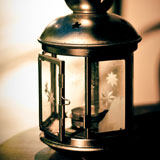Invented by Benjamin Franklin in 1761, the glass armonica (or glass harmonica) was one of the most celebrated musical instruments of the eighteenth century. Its name is derived from the Italian word, armonica, or "harmony." It's ethereal beauty and magical sound continues to capture the attention and love of musicians around the world.
HISTORY
From 1757 to 1766, Benjamin Franklin served as a delegate for colonial America.Consequently, he spent a great deal of time travelling in both London and Paris, European centers of political activity. During this period, it was quite popular and entertaining for amateur musicians to perform on sets of singing glasses . Franklin attended one of these concerts held by Richard Puckridge, an amateur, and was immediately bedazzled by the utopian and ethereal beauty of the sound. Immediately, he went to work on refining the instrument and he soon conceived a way of bringing it to professional fame.

Actual Glass Harmonica
Franklin used wine glasses of varying sizes to create his armonica. First, he removed the stems and drilled through the bottoms of the glasses. After corking the holes he had made, he mounted the glasses (in order of increasing size) onto a horizontal spindle. The spindle was rotated over a foot treadle at a rapid speed. Musicians played the instrument by touching moistened fingers to the edges of the rotating glasses. High-pitched sounds that emanated were due to the vibrations from within the air column of the glasses.
HOW DOES IT WORK?
The vibrations produced from the glasses in the armonica resonate sounds with different frequencies, and thus, musical tones are created. In Franklin's time, soda-lime glass (containing sodium) or lead glass was predominantly used. However, later experimentation has found that pure quartz (crystal) produces far superior sound quality, pitch, and tone.
When a moistened finger is held to the rim of the glass as it rotates, a pure and constant musical note is produced. This pitch cannot be altered unless one adds water to the glass, or decreases the size of the glass. Therefore, wine glasses of varying sizes are arranged on the harmonica in order to allow a musician to create melodies on the instrument.

Glass Harmonica: Note the varying sizes of the glasses used
Franklin's glass armonica included two to three octaves of the musical scale, allowing a composer greater personal expression in his or her pieces. Immediately after Franklin's invention the preeminent composers of the day, which included Mozart and Beethoven, seized the opportunity by incorporating the glass armonica into many of their most renowned works.
EXPERIMENT FOR YOURSELF!!!
 Directions:
Directions:1.Clean your finger thoroughly and moisten it with water.
2. Gently rub finger on the top edges of an empty crystal wine glass. Move finger smoothly in a circular motion, making sure to cover the entire circumference of the glass rim.
3. As you move your finger over the rim, notice the pitch of the sound produced.
4. Now, add water to the glass and repeat the same procedure. Once again, take notice of the new pitch.
WHAT HAPPENS ???

 10/13/2010 09:31:00 PM
10/13/2010 09:31:00 PM
 zhe
zhe
 Posted in
Posted in 








No Response to ""GLASS ARMONICA" (AMAZING!!)"
Posting Komentar